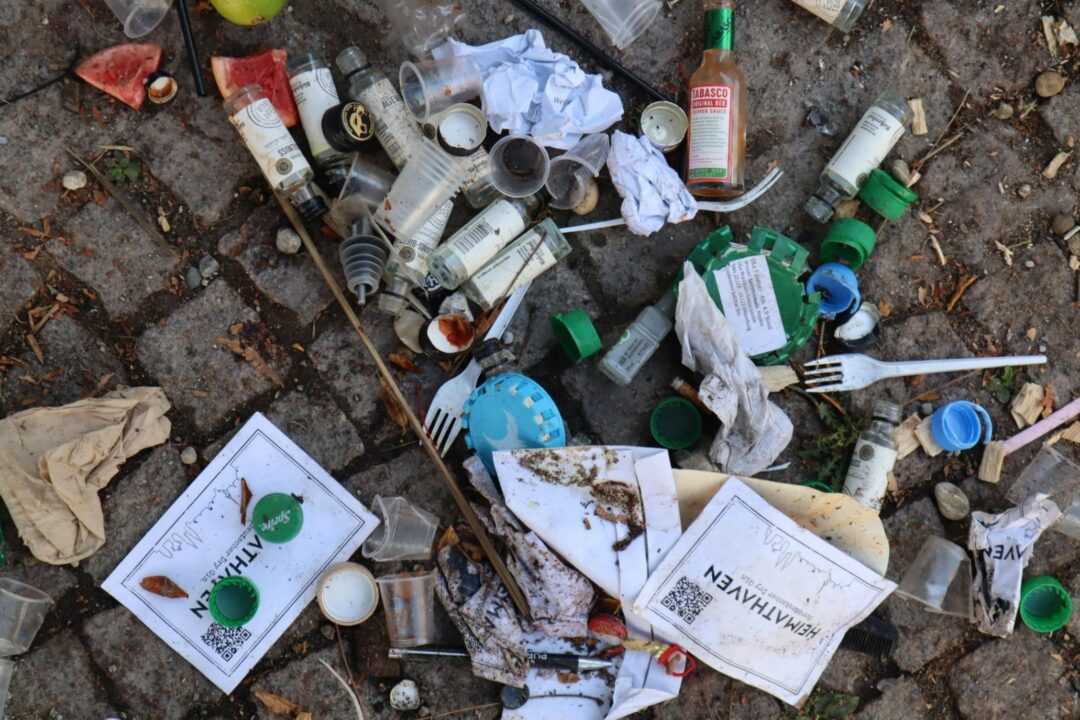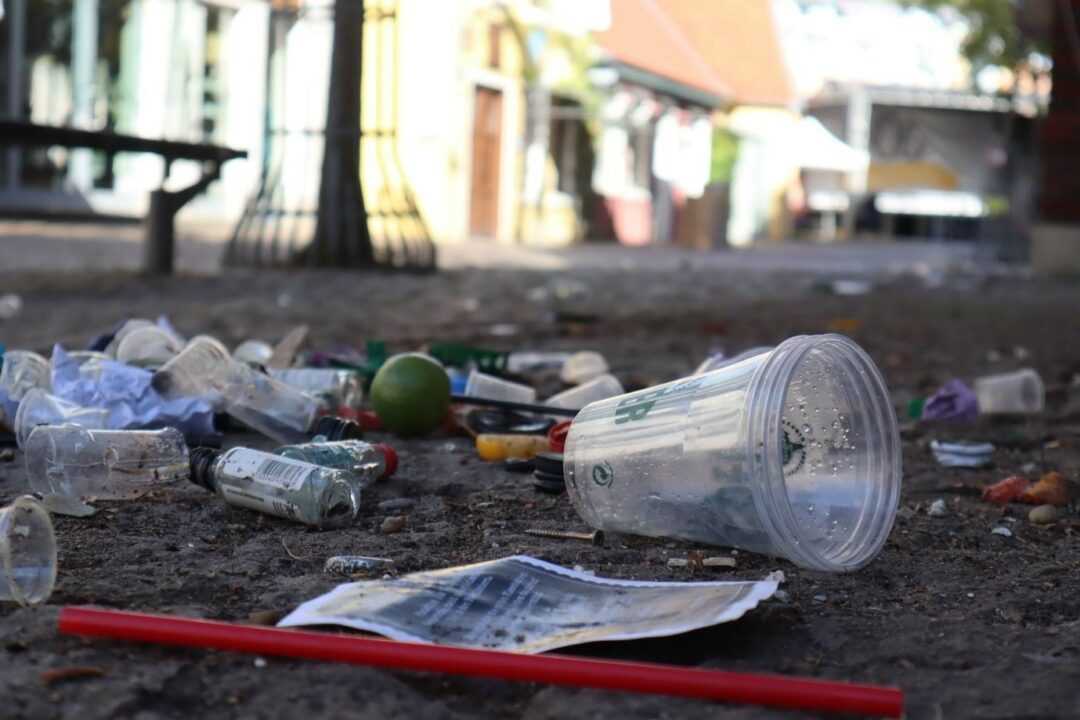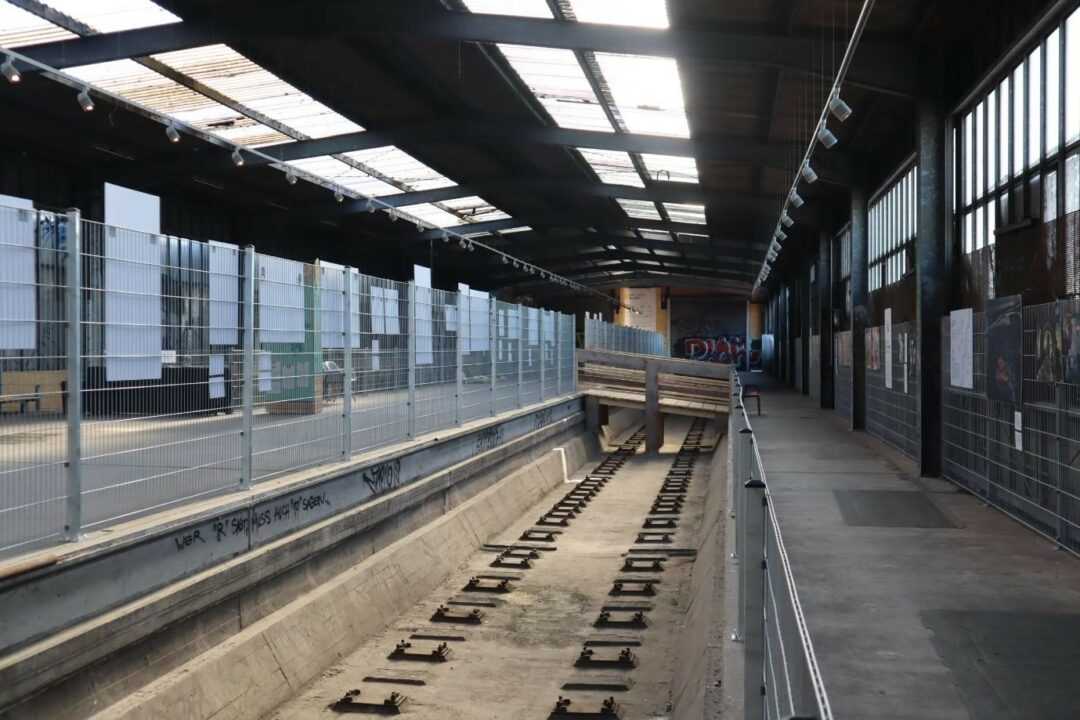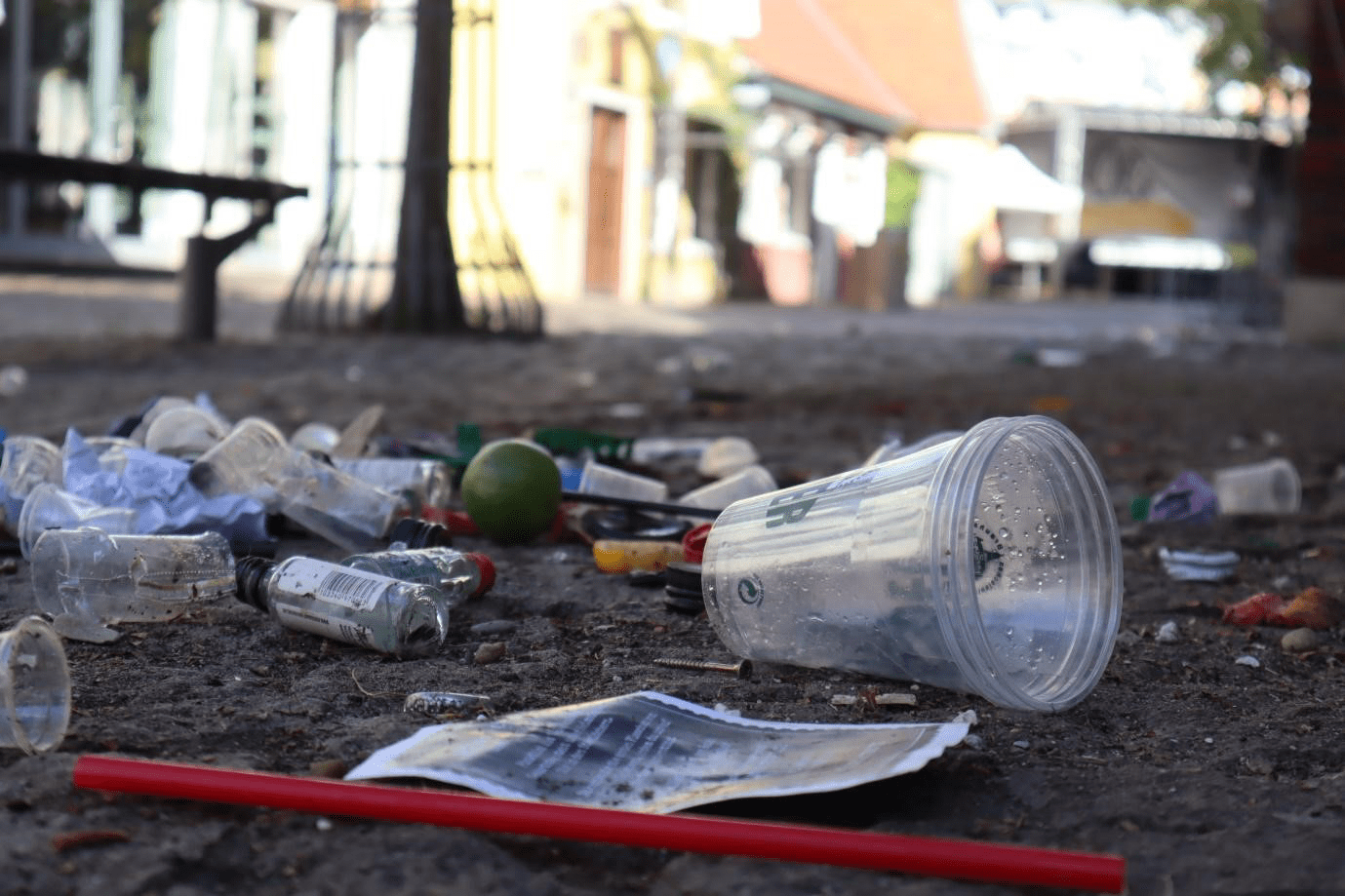This blog post is part of the ‘Plastic or Planet?’ blog series where we discuss the National Geographic exhibition ‘Planet or Plastic?’ hosted in Oldenburg during the summer of 2022. We are part of an interdisciplinary group of early career researchers working at the Helmholtz Institute for Functional Marine Biodiversity (HIFMB). Here, we focus on storytelling and reflect on the construction of dominant plastic oceans narratives.


What comes to mind when looking at the two photographs above? They both show plastic waste strewn on the floor in a street. But, what are these images saying about this place? Perhaps they suggest that this place is dirty, or that it has a problem with plastic waste. However, as we will argue in this blog post, it is difficult to come to any conclusions just by looking at these images.
Indeed, the way in which you, our audience, interpret these photographs is informed by your own positionalities – who you are, where you live, as well as your own experiences with plastic waste. Moreover, how, where, and who is showing you these images also matters in how you make sense of their meaning.
These photographs were taken during the summer of 2022, early on a Sunday morning after a weekend street festival, a few streets away from the Planet or Plastic? National Geographic exhibition in Oldenburg, Northern Germany.
An hour after the images were taken, the street was cleaned. All traces of plastic waste were gone. However, these images are not showing you this. They capture a moment using a particular frame and angle. You cannot see the people that left this plastic behind; the labour involved in producing or collecting it; or where this plastic waste is going next.
An image without context can potentially say a lot, while also saying nothing at all. However, images can be highly political and have profound impacts on the ways in which stories about places, people, and historical events are told. Photography is visual storytelling – a powerful art that produces, maintains, and disrupts long-lasting narratives by temporarily focusing, blurring, and capturing light patterns in space. As Susan Sontag, writer and political activist, claimed, it is a device that provides a reaction from an audience, an experience that gives “the appearance of participation” beyond the relationship between the photographer and the event/subjects1. Photographs, then, have played a critical role in creating stories, surrounding the past, present, and future state of the planet and our oceans.
In this blog, we reflect on the use of photography in the Planet or Plastic? exhibition, and the way in which National Geographic builds their narrative on what they call “the global plastic trash crisis”.2
Producing Difference
National Geographic is a popular magazine founded in 1888 in the United States of America (USA), currently owned by Disney Publishing Worldwide. It is famous for their monthly editions that use photographs with short captions to cover geographical stories on science, history, culture, and travelling. For over a century, this magazine has deeply influenced the ways in which people, especially in the North, engage and represent foreign places and people.
We use ‘North’ and ‘South’, not as geographical concepts. Instead, we draw on Esteban Krotz (1993)3 who uses this divide as a metaphor to denote the social, economic, and ecological inequalities caused by capitalism and colonialism on a global scale. The North refers to the dominant and colonial ways of being and knowing, while the South denotes the experiences of excluded and marginalised groups.
Lutz and Collins in their book Reading National Geographic (1993)4 argued that this magazine offers a view on the world centred in the USA, highlighting the role that the magazine has played in the production of difference. Here, they refer to the ways in which the stories presented by National Geographic reinforce social hierarchies, in which places and peoples in the South are represented as exotic, primitive, and savage, while dominant Eurocentric science, social, and cultural values are positioned at the centre, as desired (i.e., the North).
As Lutz and Collins highlight, most photographers publishing in National Geographic carefully edit and share critical stories, many actually do this in their own independent work. However, these stories are often lost or ‘attenuated’ (i.e., placed on the background) during the magazine’s editing processes.
Experiencing the “Planet or Plastic?” Exhibition
The Planet or Plastic? exhibition in Oldenburg contains a mixture of street photography, photojournalism, and wildlife photography. Upon entering the vast space, you move through a narrow walkway, where images, fixed onto steel structures, were printed out with sporadic short captions offering information about the photographs and plastics’ role in society (see image below).

We identified six main thematic sections: i) Made in China, ii) Plastic as a solution; iii) Plastic pollution and oceans; iv) Artistic interpretations of Plastic waste; v) Recycling and technological fixes, and vi) Plastic research and sponsors. For a description of these themes in order of appearance please click below.
The first series of photographs is the collection ‘A Rainbow of Plastics’ (photographer Richard John Seymour). They consist of street photography images of shopfronts at the Yiwu International Trade City in China, where the shopkeepers are almost consumed by the plastic goods they are selling. From toys, inflatable dinghies to backpacks, the whole frame of the photographs bursts with colourful plastics, while shopkeepers appear as seemingly unaware or indifferent to the photographer’s presence.
At the end of the row of photographs, an accompanying text states that they were taken by the photographer in a location that they felt was both familiar, because of the type of products on sale, as well as unfamiliar due to the ‘mind boggling’ scale of plastic products on sale. These images are a good example of what street photography can do; that is, give real time glimpses into the intimacies and dynamics of everyday life, capturing the essence of an undisturbed moment that would otherwise be lost if the subjects were asked to pose. Although for some, the ethics of street photography are contentious due to issues of consent and editorial control, as an artistic medium, it is recognised as making significant contributions for giving alternative insights into culture by making the ‘ordinary extraordinary’5 (for more on the ethics of street photography, see Hadley 2022).6
On their personal website, Richard John Seymour7 explains that the images show how each vendor sells goods by the thousands to be exported across complex networks, to a world of dispersed consumers. Presenting the project as an analogy to the manufacturing processes utilised in the factories surrounding Yiwu, the images are presented in a repetitive manner, to be exhibited as a highly saturated and chaotic installation of consumer excess, and ultimately to be consumed by a foreign audience. However, this information was omitted from the exhibition captions, which instead emphasise China’s role in the production and consumption of plasticas the world’s largest producer of plastic.
Although China is one of the world’s largest producers of plastic waste, this ignores the complex political economies and power relations shaping the history of plastic. What about the polymer producers, the single use plastic consumers, and the interchanging web of global relationships with plastic? Opening the exhibition with the ‘Rainbow of plastics’ thus poses interesting questions in relation to the story that the Planet or Plastic? exhibition is seeking to tell.
The exhibition continues with a section called ‘Plastics in Peacetime’, which contains a couple of black and white photographs of life in the USA from the 1950’s. One image shows a family joyfully throwing disposable plastic waste in the air as it rains down on them, whilst they stand next to a bin full to the brim with plastic waste (photographer Peter Stackpole). Here, plastic is conceived as a product that is seemingly essential for a more convenient lifestyle, contributing to a throwaway society that promotes endless consumption.
The order of the photos begs the question, why jump chronologically from current China to the 1950’s USA without any clear transition? What does this tell us about the history of plastic? Maybe not much, the absence of a clear transition leaves the connection between these very different moments and places up for interpretation, especially considering the political tensions and history between the USA and China. The order of the photos appears to be curated without carefully developing a coherent storyline.
As we continue to walk along the gangway, the exhibition then emphasises the various uses of plastic in manufacturing. These include a drone shot of a Dow Chemical Company plant (hereafter Dow) in Texas (photographer Randy Olsen). The exhibition narrative presents the plant in terms of “Modern Plastic Manufacturing”, without acknowledging that Dow is the third largest producer of single use plastics in the world. This seems rather important in the history of plastic, especially taking into account that Dow has been found responsible by the USA Environmental Protection Agency (EPA) for violating the Clean Air Act, Clean Water Act, and the Resource Conservation and Recovery Act on several instances (see, for example, the EPA’s 2011 settlement).8
Dow’s violations include the illegal discharge of high levels of dioxins and other pollutants in the Tittabawassee and Saginaw Rivers flowing into the Saginaw Bay (dioxins are highly toxic and linked to cancer and other health problems in reproductive and immune systems); as well as air pollution from petrochemical and chemical flares in Louisiana and Texas (see EPA’s 2021 settlement).9
Following on with the exhibition, there are images from all over the world displaying the various ways in which plastics are essential to transport systems, medicine, sports, security, and hygiene among other important uses (photographers Randy Olsen, Craig Cutler, Yasuyoshi Chiba, Dan Westergren, and Jonas Bendikson). By themselves, these images are very powerful reminders of how everyday life for the majority of people involves deep connections to plastics and the many ways in which the invention of plastic has revolutionised technological innovations. However, again, it is not clear what these images are telling us about the proposed exhibition title question: Planet or Plastic?
This section focuses on the problematic consequences of plastic waste. It begins with two images which are seemingly linked by a pair of pink, plastic flip flops. In the first image, we see a factory in Bangladesh where these flip flops are produced, the image that follows is that of a similar pink, plastic flip flop submerged in the rivers of Manila (photographer Randy Olsen). The two photos are chosen to show the “lifecycle of disposable plastic”, yet the exhibition presents these images of what they call “inexpensive plastic products”, as emanating from so-called “Asian Nations”, reinforcing the idea of these countries as both producers and polluters.
The exhibition then becomes fragmented as it jumps into the impact of plastics on the ocean without any clear transition in the overall narrative. Some of the most well-known, impactful and thought provoking images appear in this section; an image of a loggerhead turtle caught in fishing nets off the coast of Spain (photographer Jordi Chias), a surfer on Java, Indonesia riding a wave as it breaks, the crest filled with trash (photographer Zak Noyle), and scenes of used, disposable masks from the COVID-19 pandemic, littering a beach in Northern Poland. They are used to emphasise “another plague”, suggesting that the world’s obsession with plastic is itself a pandemic (photographer Jakub Rybicki).
In this section, the placement of two unexpected photographs showing women and children in landfills submerged in plastic waste (photographer Randy Olson). One of these images is presented next to the flip flops, with a caption stating that only 10% of plastic waste is globally recycled. The other image appears next to the images of oceanic plastic pollution, with a deeply problematic caption titled “a bright spot in the darkness” where it is recognised that plastic pollution is a problem, while at the same time presenting plastic recycling as “providing a glimmer of hope”. It is worth asking: “recycling for whom?”. Indeed, by focusing on recycling, the exhibition fails to consider the problems associated with presenting racialised, gendered, and socio-economically marginalised people and their children working in unsanitary and inhumane conditions as positive or hopeful.
Finally, an outdated infographic map titled “Drowning in plastic” (drawn by Jason Treat and others)10, oddly depicts plastic waste flows into oceans, only from large river basins in Asia, Central and South America, and Africa, but not from North America, Europe, and Australia. Stay tuned to our “Plastic Geopolitics – Narratives from the South” blog post for a deeper reflection of these issues.
This section displays images of art pieces that have been created from, and with plastic waste. These include photographs of frozen popsicles which use dirty water from sites around Taiwan filled with trash, cigarette butts, and oil to capture the contamination of water in a playful way, provoking the audience, and asking: “would you consume this product?” (photographer Zheng Yu-Ti). This is accompanied by a series of images where ocean trash is photographed as if held in suspension and ordered to look like shoals of fish, and jellyfish (photographer Mandy Barker).
These images highlight the critical role that art can play in contributing to alternative interpretations to discussions surrounding environmental problems. In contrast to the documentary photography presented in the rest of the exhibition, it draws attention to plastic particles and objects to reflect on water pollution.
Some of these art pieces focus on particular events and objects, for instance, the 2014 spill of printer cartridges and the collection of soccer balls washed ashore in European countries (photographer Mandy Barker). Moreover, the images of plastic debris suspended in the so-called ‘Garbage Patch’ in the North Pacific Ocean as well those from the Japanese tsunami debris expedition in 2012. Taken by the same photographer, these images creatively show how plastic can resemble marine and natural entities, including groups of fish, bird’s nests and seahorses.
Although the image captions could have been more provocative and worked to connect these artistic interpretations of plastic waste to the overall narrative in the exhibition, we enjoyed this section and thought it opened space to think about the movement of plastic in the water, while also linking plastic waste to disasters and everyday plastic uses.
This section had a series of documentary type images of a recycling plant, a reusing depot, and sorting machinery emphasising the future of plastic waste. This is contrasted with an image titled ‘low-tech’ recycling of a person sorting through a sea of plastic bottles in the Toplun Plastic Corporation at the outskirts of Manila, which the image caption argues is “only possible through low-cost labour”, again, without noting or even questioning the environmental and social justice implications of such work (photographer Randy Olsen).
It then moves on to images of technological fixes. The examples offered are all within highly technified and privileged industrial complexes in the North, with images of composting and recycling in France, zero-waste lifestyle in California, circular economy in New Jersey’s largest indoor vertical farm, and Arizona’s largest aircraft dismantling and repurposing facility (photographer Luca Locatelli).
An infographic displaying the challenges of recycling shows that not all plastics are recycled in North America, where only 18% of plastics are recycled, revealing the percentage per type (e.g., PET 11%, PVC 5%, PP 19%, etc.). If these plastics are not recycled and are not flushed in the rivers as shown by the map (in the Plastic pollution and oceans section), it is important to question: where is 82% of plastic waste going? Who is bearing the costs and dealing with the consequences of managing this waste?
Instead of addressing these crucial questions, the exhibition reinforces a narrative in which the North is a-historically and a-politically framed as solving the problems from the South.
The exhibition then finishes with photographs of some of the scientists who are working within the realms of plastics. National Geographic introduces the Ocean Plastic Innovation Challenge, which is a partnership that aims to respond to the issues of plastic pollution focusing on design, circular economy, and data visualisation.
Images with some of the ideas submitted by nearly 300 teams entering the challenge reveal technological innovations connected to the use of plastics in toothbrushes, cigarette buds, plastic cutlery and shoes, among others. Captions offer short recommendations and powerful messages, inviting visitors to recycle cigarette buds and tires, avoid using plastic shoes, cutlery, and wraps, as well as switching to bamboo toothbrushes. These innovations are presented as solutions that have already been selected by companies to support their implementation. In this challenge, design ideas and data visualisation were judged on the basis of showing the problem of plastic and prompting action.
But, aren’t these ‘solutions’ the tip of the iceberg of plastic waste? In line with the experience of National Geographic on documenting and working on the environmental impacts of plastics, it is disappointing that political and economic strategies were not discussed or acknowledged in this exhibition.
Towards the end, there are promotional images from the sponsors: EWE (Energieversorgung Weser-Ems), the 5th largest energy provider in Germany, and ZWT e.V. (Forschungsverbund Zentrum für Werkstoffe und Technik), a network of plastic resource and technology companies. This raises two ethical concerns: i) what was the role that these companies played in shaping the overall narrative of the exhibition, and ii) why rely on funds from companies that economically benefit from the expansion of plastic production, consumption, and waste? (see blog post “Behind the scenes of the National Geographic exhibition ‘Planet or Plastic?’”)
Powerful Narratives
The Planet or Plastic? exhibition highlights the effectiveness of photography to transport the viewer into a world where the multiple uses, stressors, and problems surrounding plastic production and consumption are vividly displayed. How an audience interprets and analyses an image is subjective, and the Planet or Plastic? exhibition does convey a diverse range of powerful photographs which show how effective art can be in making an audience stop to think about a particular issue.
However, as important as offering thought provoking images are the ways stories are created and curated. Bringing together photographs from multiple photographers requires a responsibility and sensitivity to create a thread which cohesively shows the complexity of the issue of global plastic waste. Of course, this is not an easy thing to do. Indeed, the exhibition offered limited critical engagement with current political and scientific debates on plastic.
In ignoring historical and uneven power dynamics, the exhibition over-emphasises the role of Asian countries in the production of plastic, and technological fixes as solutions, while overlooking the complex historical relations of plastic production, consumption, and waste management with colonial capitalism. Thus, failing to bring light or engage with the role of corporations, nation-states, and international agencies in supporting, profiting from, and maintaining a growing plastic production, as well as the uneven distribution of impacts of waste management and pollution.
More thought needs to be put into how exhibitions are displayed and the purpose of the conversations they aim to create. We would argue that an editorial work that empowers narratives of social and environmental justice requires reflexive approaches that pay attention to historical power relations, thus, remaining critical of the exhibition curators and funders own positionalities, as well as the positionality of potential audiences. This involves carefully considering the importance of place, not only in terms of how places are represented, but the place of viewers in receiving and relating to the information presented to potentially create other stories.
Concluding thoughts on the capturing of ocean stories
So, what does this tell us about ocean stories? As we enter the United Nations’ Ocean Decade, using art (including photography, music, film, animation, sound, performance, sculpture etc.) emerges as critical in sharing and producing powerful ocean stories.
Although this blog has analysed the way stories are told by an established institution such as National Geographic, the ‘curating’ of ocean stories is no longer only the responsibility of exhibitions like Planet or Plastic?. Social media users are increasingly playing an active role in sharing stories via photos and videos in WhatsApp, Facebook, Instagram, TikTok and so on, accessing, sharing, and analysing photographs in their everyday lives. On the one hand, this means that more people than ever can contribute and have access to control how ocean stories are told, offering alternative perspectives that cut through the uneven power dynamics that might be present in an exhibition like Planet or Plastic?. On the other hand, this also means that editing and curating stories is a lot more difficult to do, considering issues of responsibility and accountability over the stories being shared.
As researchers, we are also storytellers. The images we use to speak about the oceans, their accompanying text or captions, where these images are displayed and for whom, as well as their overall purpose matters. Therefore, analysing the ways in which ocean stories are constructed and conveyed, pose critical questions relating to representation, ethics, and the power of the stories being shared during the next decade, the UN Ocean Decade. Stories of the oceans will increase manifold, how, why, and who tells these stories will be fundamental in discussions surrounding environmental justice11.
Going back to the images that opened this blog post, and the many other images we see every day in the news and social media, as well as in our own work, we invite critical reflection on the context and stories being shared, and broader acknowledgement of the limits of our own interpretations. In paying attention to the ways in which ocean stories are shared, we emphasise their potential to “move hearts, minds, and bodies” as highlighted by Tara Houska Zhaabowekwe, Couchiching First Nation (2019)12 Tribal attorney and climate justice activist. Indeed, we all have an important role to play in offering and demanding more careful and contextualised practices of environmental storytelling.
Sources
1 Sontag, S. (1979) On Photography. New York: Rosetta Books.
2 Available at: https://www.nationalgeographic.com/environment/topic/planetorplastic
3 Krotz, E. (1993) La producción de la antropología en el Sur: características, perspectivas, interrogantes. Alteridades, 3(6):5-10.
4 Lutz, C.A. & Collins, J.L. (1993) Reading National Geographic. Chicago: The University of Chicago Press.
5 Jardin, V. (2017) Street Photography Creative Vision Behind the Lens. New York: Taylor and Francis
6 Hadley, J. (2022) Street Photography Ethics. Ethical Theory Moral Practice. https://doi.org/10.1007/s10677-022-10316-6
7 Available at: https://richardjohnseymour.com/yiwu-commodity-city
8 EPA (2011) Dow Chemical Company Settlement. Available at: https://www.epa.gov/enforcement/dow-chemical-company-settlement.
9 EPA (2021) The Dow Chemical Company, Performance Materials NA, Inc, and Union Carbide Corporation Clean Air Act Settlement. Available at: https://www.epa.gov/enforcement/dow-chemical-company-performance-materials-na-inc-and-union-carbide-corporation-clean.
10 Available at: https://blog.education.nationalgeographic.org/wp-content/uploads/2018/05/drowning-in-plastic.jpg
11 Hadley, J. (2022) Street Photography Ethics, Ethical Theory Moral Prac.
12 Houska, T. (2019) What Listening Means in a Time of Climate Crisis. Available at: https://lithub.com/what-listening-means-in-a-time-of-climate-crisis/
Geraint Rhys Whittaker & Paula Satizábal
Editorial input from Jasmin Groß, Rebecca Borges, and Josie Antonucci Di Carvalho
